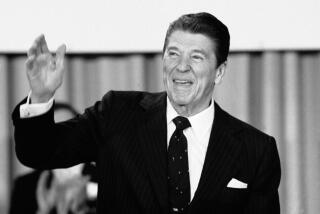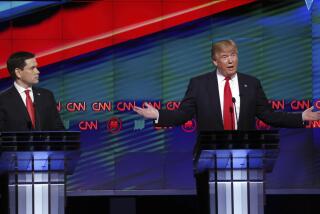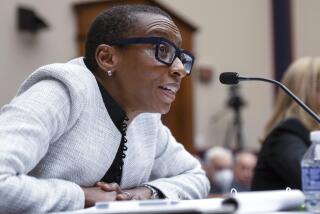Old guard back on Iraq policy
- Share via
WASHINGTON — Ever since Iraq began spiraling toward chaos, the war’s intellectual architects -- the so-called neoconservatives -- have found themselves under attack in Washington policy salons and, more important, within the Bush administration.
Eventually, Paul D. Wolfowitz, the Defense department’s most senior neocon, went to the World Bank. His Pentagon colleague Douglas J. Feith departed for academia. John R. Bolton left the State Department for a stint at the United Nations.
But now, a small but increasingly influential group of neocons are again helping steer Iraq policy. A key part of the new Iraq plan that President Bush is expected to announce next week -- a surge in U.S. troops coupled with a more focused counterinsurgency effort -- has been one of the chief recommendations of these neocons since the fall of Saddam Hussein in 2003.
This group -- which includes William Kristol, editor of the Weekly Standard magazine, and Frederick W. Kagan, a military analyst at a prominent think tank, the American Enterprise Institute -- was expressing concerns about the administration’s blueprint for Iraq even before the invasion almost four years ago.
In their view, not enough troops were being set aside to stabilize the country. They also worried that the Pentagon had formulated a plan that concentrated too heavily on killing insurgents rather than securing law and order for Iraqi citizens.
These neoconservative thinkers have long advocated for a more classic counterinsurgency campaign: a manpower-heavy operation that would take U.S. soldiers out of their large bases dotted across the country and push them into small outposts in troubled towns and neighborhoods to interact with ordinary Iraqis and earn their trust.
But until now, it was an argument that fell on deaf ears.
“We have been pretty consistently in this direction from the outset,” said Kagan, whose December study detailing his strategy is influencing the administration’s current thinking. “I started making this argument even before the war began, because I watched in dismay as we messed up Afghanistan and then heard with dismay the rumors that we would apply some sort of Afghan model to Iraq.”
If Bush goes ahead with the surge idea, along with a shift to a more aggressive counterinsurgency, it would in many ways represent a wholesale repudiation of the outgoing Pentagon leadership.
These leaders -- particularly former Defense Secretary Donald H. Rumsfeld and Army Gen. John P. Abizaid, the departing Middle East commander -- strongly resisted more U.S. troops and a larger push into troubled neighborhoods out of fear it would prevent Iraqis from taking over the job themselves and exacerbate the image of America as an occupying power.
The plan the administration appears moving toward envisions an increase of 20,000 to 30,000 troops, the majority of whom would be sent to Baghdad. The increase would be achieved by delaying the departure of Marine units already in Iraq and speeding the departure of Army brigades due to deploy this spring.
The neoconservative group had been the driving force in Washington behind a move against Iraq, even before the Sept. 11 terrorist attacks. They saw Hussein as a lingering threat to world security -- a view bolstered within the administration following 9/11. And they argued that transforming Iraq into a democracy could serve as a model to remake the Middle East’s political dynamics.
The problems with the war gradually undermined the clout they had wielded. But perhaps the more important hurdle to their views being heeded -- especially on military matters -- was the White House’s refusal to see its Iraq policy as a failure.
That changed this summer, when the spike in sectarian violence and the failure of an offensive to secure Baghdad created what one Pentagon advisor called a “psychological break” within the administration. Until then, neoconservatives argued, the administration saw little proof that Abizaid’s plan, which was backed by Army Gen. George W. Casey Jr., the military commander in Iraq, was failing.
The main reason for the new ascendancy of the neocon recommendations, said Kristol, is that “the Rumsfeld-Abizaid-Casey theory was tried and was found wanting.... Some of us challenged it very early on, but, of course, then we were just challenging it as a competing theory.”
Although Kristol, Kagan and their intellectual allies have pushed hard for their policy change for more than three years, they bristle at the notion that the idea of a larger troop presence in Iraq and a different approach to securing the country is wholly a neoconservative idea.
Sen. John McCain of Arizona, a leading Republican presidential contender, has been pushing for more troops and a different security strategy for nearly as long as Kristol and Kagan. Recently, support for a revised counterinsurgency plan also has gained support among military officers, active and retired. Perhaps most notable among this group is retired Army Gen. Jack Keane, a former Army chief of staff who signed on to Kagan’s plan last month.
The case for change has been bolstered by actions the military has taken, including a successful 2005 Army offensive in the northern Iraqi city of Tall Afar, where midlevel officers used counterinsurgency tactics to suppress sectarian violence. In addition, the Pentagon released a new counterinsurgency field manual last month that largely echoed Kagan’s thinking.
Some leading neoconservatives do not embrace the troop surge proposal.
Wolfowitz, for instance, ridiculed the notion that more troops would be needed to secure Iraq than were used in the invasion.
And Richard N. Perle, a former top advisor to the Pentagon who also advocated for smaller troop numbers at the time of the invasion, is known to be skeptical of the idea of a surge.
The plan’s advocates acknowledge the split.
“Before the war, I was arguing for a quarter of a million troops in expectations we’d be there five or 10 years,” said Gary J. Schmitt, an analyst at the American Enterprise Institute who has worked closely with Kristol and Kagan. “Richard Perle, obviously somebody else who’s thought of as a neocon, thought we should go in” with far fewer U.S. forces.
The neocons calling for more troops in Iraq and different tactics have pressed their proposals in public writings and speeches and in more private conversations within the administration.
Kenneth L. Adelman, another leading neoconservative thinker, recalled a meeting a year ago of the Defense Policy Board, a group of outside advisors to the Pentagon, where he pressed Rumsfeld -- a longtime friend -- to implement more traditional counterinsurgency ideas, such as keeping soldiers longer in their deployed areas so they could get to know the local population.
“What you need for counterinsurgency has been pretty clear for some time: You need to protect the population and get the population to fight the insurgents with you, or at least inform on them,” Adelman said. “The fight is over the population, it’s not over getting the enemy.”
And much like they did when advocating for the invasion, these neocons have promoted their military strategy even at times when it was seen as politically unpalatable.
“What you can say about Fred Kagan and Bill Kristol, whatever else you want to say, is they’ve been constant in sounding this theme,” said Eliot A. Cohen, a military analyst at Johns Hopkins University’s international studies school in Washington who has advised the administration on Iraq policy. “You’ve had other people who have dropped in and out of this.”
*
(BEGIN TEXT OF INFOBOX)
Neocon philosophy
Neoconservatives are best known for advocating aggressive foreign and military policies to implant democracy and American values abroad.
It is a school of thought that attained prominence in the foreign policy of the Reagan administration and, more recently, in that of George W. Bush.
Neoconservatives have been especially focused on the Middle East.
They have argued that building democracy in the Arab world could foster reform throughout the region.
*
Los Angeles Times
More to Read
Sign up for Essential California
The most important California stories and recommendations in your inbox every morning.
You may occasionally receive promotional content from the Los Angeles Times.










